Trauma: Vascular Exposure
Exposure of the Great Vessels
Incisions/Technique
Innominate Artery
- Access: Median Sternotomy
- Patients in Extremis May Require a “Clamshell” Thoracotomy
- May Require Division of the Left Innominate Vein to Expose the Aortic Arch
Common Carotid Artery
- Proximal Access: Median Sternotomy
- Distal Access: Traditional Cervical Incision Along the Anterior Border of the Sternocledomastoid Muscle
Right Subclavian Artery
- Proximal Access: Median Sternotomy
- Distal Access: Supraclavicular Incision
Left Subclavian Artery
- *Generally Considered the Most Difficult to Expose
- Proximal Access Options:
- Anterior Left Thoracotomy Through the Third Intercostal Space
- Exposure is Limited
- Resuscitative Anterolateral Left Thoracotomy
- Through the Fifth Intercostal Space
- Can Be Extended into a “Clamshell” Thoracotomy
- Median Sternotomy with Supraclavicular Extension
- “Trap Door” Incision
- Three Components: Anterolateral Left Thoracotomy, Partial Sternotomy & Left Supraclavicular Incision
- Considered the Classical Incision but is Associated with More Severe Bleeding & Respiratory Complications
- Generally Not Used in Modern Practice
- Clavicular Resection
- May Require Addition of Median Sternotomy to Improve Proximal Access
- Anterior Left Thoracotomy Through the Third Intercostal Space
- Distal Access: Supraclavicular Incision
- Artery is Deeper & More Difficult to Expose than on the Right-Side
- Can Resect the Clavicle to Improve Access
Vertebral Artery (Segment V1)
- Access: Supraclavicular Incision
- Segments V2-V4 Require Specialty Expertise Through Bony Segments
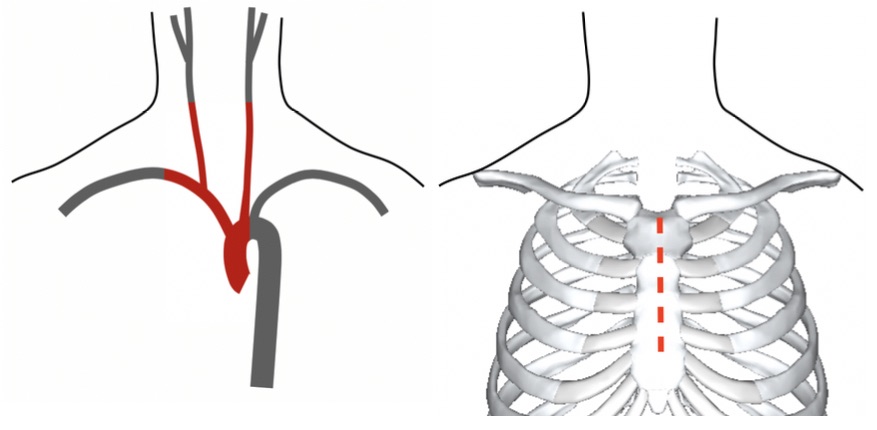
Exposure by Median Sternotomy

Exposure by Cervical Incision
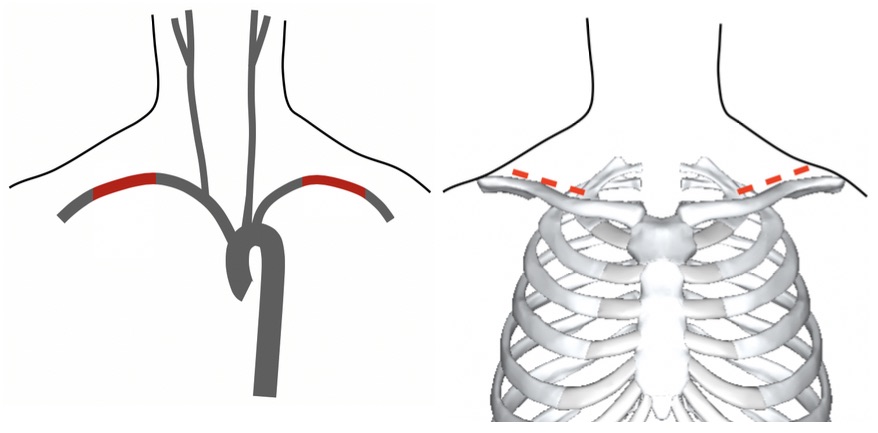
Exposure by Supraclavicular Incision

Access to Left Subclavian (Thoracotomy, Trap Door & Clavicular Incisions)
Upper Extremity Vascular Exposure
General Thought
- Can Consider a Single Line to Expose the Majority of the Upper Extremity Vessels
- From the Infraclavicular Incision, Down the Bicipital Sulcus, Obliquely Across the Antecubital Fossa, & Along the Radial Volar Forearm
- Separate Incision Needed Only for the Ulnar Artery
Axillary Artery
- Incision: Infraclavicular Incision (Mid-Clavicle to Deltopectoral Fascia)
- Divide the Pectoralis Major Muscle 2 cm from the Humeral Insertion
- Can Spare if Stable with No Active Bleeding (Retract Medially or Split)
- Divide the Pectoralis Minor Muscle to View the Second Portion of the Axillary Artery
- Can Use an Army-Navy Retractor to Elevate & Assist Division
- May Require Division of Medial Clavicle for Proximal Exposure
- Associations:
- Axillary Vein Generally Runs Inferior to the Artery
- Brachial Plexus Can Be Easy to Confuse with the Artery
Brachial Artery
- Incision: Longitudinal Medial Incision Over the Bicipital Sulcus (Between Biceps & Triceps)
- Neurovascular Bundle Identified Between the Muscle Bellies
- Take Care to Avoid Iatrogenic Injury
- Easy to Confuse Artery with Median Nerve
- To Expose the Bifurcation:
- Extend Incision Obliquely Across the Antecubital Fossa
- Divide the Bicipital Aponeurosis (Dense Fibrous Extension of the Bicipital Tendon) to Expose the Bifurcation
- *Level of Bifurcation is Extremely Variable
Forearm Arterial Exposure
- Radial Artery: Incision Along the Inferomedial Border of the Brachioradialis Muscle
- Along the Radial Volar Forearm
- Retract the Brachioradialis Muscle Laterally to Expose the Fat Pad
- Proximal Radial Artery/Nerve Identified in this Fat Pad
- Ulnar Artery: Separate Incision Along the Ulnar Volar Forearm
- Neurovascular Bundle Identified in the Fat Pad Between the Flexor Digitorum Superficialis & Flexor Carpi Ulnaris
- Oblique Incision Over the Antecubital Fossa May Be Required for Proximal Access to the Bifurcation

Upper Extremity Incisions
Lower Extremity Vascular Exposure
Iliac Vessels
- Common Iliac Vessels: Laparotomy
- External Iliac Vessels:
- Laparotomy (Most Expedient)
- Retroperitoneal Approach
- Retroperitoneal Approach:
- Curvilinear Incision from the Inguinal Ligament to 2 cm Above the Anterior Superior Iliac Spine (ASIS)
- Carried Down Through the Fat/Subcutaneous Tissue
- Incise the Fascia of the External Oblique & Transversalis
- Avoid Entry into the Peritoneum
- Avoid Injury to the Ureter – Crosses Over the Bifurcation
- Can Extend Incision Inferiorly (“Hockey Stick”) with Division of the Inguinal Ligament for More Distal Exposure
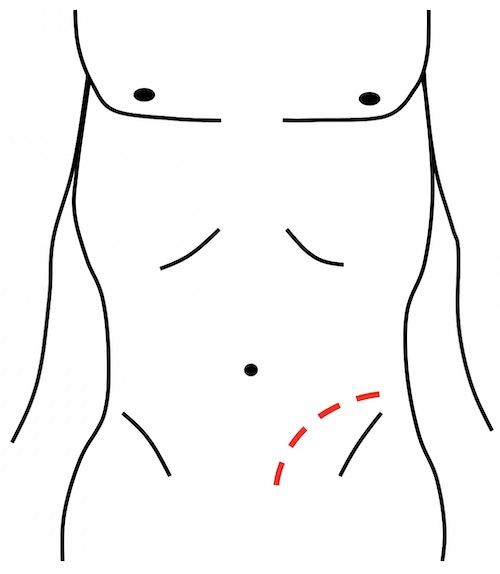
Iliac Exposure
Proximal Femoral Vessels
- Incision: Vertical Incision 2-Fingerbredths Lateral to the Pubic Tubercle
- Proximal Extent: Inguinal Ligament
- Approximated by a Line from the Pubic Tubercle to the ASIS
- Groin Crease Generally Results in the Incision Being Too Low
- Extend Caudally Along the Medial Border of the Sartorius Muscle
- Proximal Extent: Inguinal Ligament
- Femoral Triangle
- Borders:
- Inguinal Ligament
- Medial Border of the Sartorius Muscle
- Medial Border of the Adductor Longus Muscle
- Contents:
- Common Femoral Artery (CFA)
- Proximal Superficial Femoral Artery (SFA)
- Proximal Profunda Femoral Artery (PFA)
- Common Femoral Vein – Medial to Artery
- Femoral Nerve – Lateral to Artery
- Common Femoral Artery (CFA)
- Borders:
- Open the Femoral Sheath to Expose the Common Femoral Vessels & Bifurcation
- Avoid Injury to the Lateral Femoral Circumflex Vein – Crosses Over the Profunda Femoral Artery at the Bifurcation
Distal Superficial Femoral Artery (SFA)
- Incision: Along the Medial Border of the Sartorius Muscle
- Retract the Sartorius Medially to Expose Hunter’s Canal
- Unroof Hunter’s Canal to Expose the Distal SFA
- Hunter’s Canal:
- Canal Travelling Under the Sartorius Muscle Containing the Femoral Neurovascular Bundle
- Extends from the Apex of the Femoral Triangle to the Adductor Hiatus
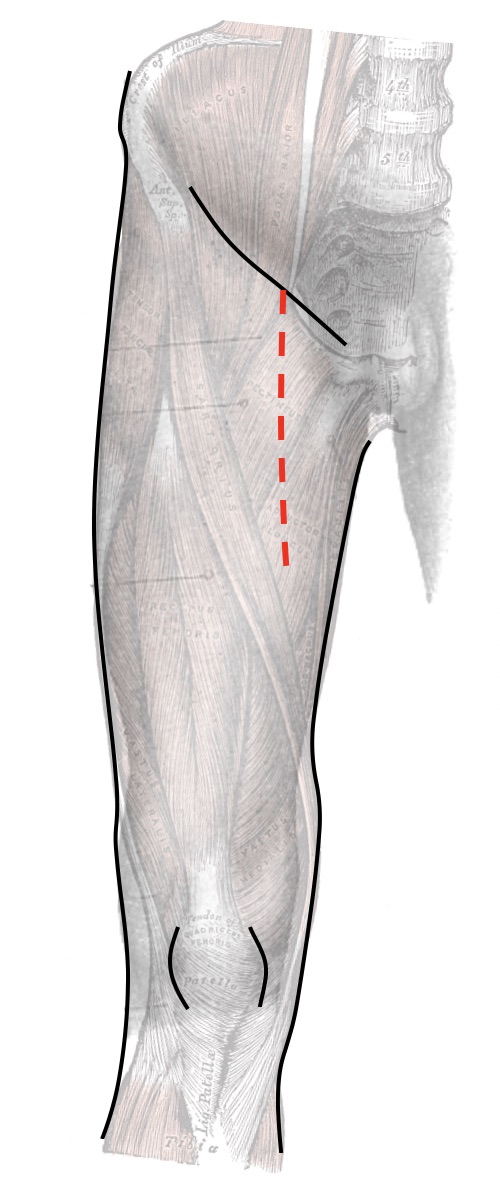
Proximal Femoral Exposure

Distal SFA Exposure
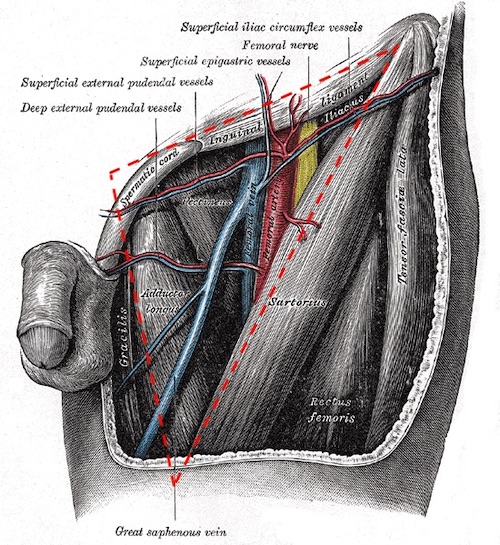
Femoral Triangle
Popliteal Artery
- Positioned in a Frog-Leg
- Hip Abduction with Slight Lateral Rotation & Knee Flexion
- Bump Under the Knee to Maintain Position
- Above the Knee Exposure:
- Incision: Medial Lower Thigh Between the Vastus Medialis & Sartorius Muscles
- Vascular Sheath Identified in the Fat Pad Between the Vastus Medialis & Sartorius Muscles
- May Require Division of the Adductor Magnus or Sartorius Muscles
- Popliteal Artery is Encountered First (Medial to the Vein)
- Avoid Injury to the Saphenous Vein
- Below the Knee Exposure:
- Incision: Longitudinal Medial Incision 1 cm Posterior to the Tibia
- 10 cm Length Starting 1-2 cm Distal to the Medial Femoral Condyle
- Retract the Gastrocnemius Muscle Inferiorly
- Dissect the Soleus Muscle Off the Posterior Tibia
- Popliteal Vein is Encountered First (Medial to the Artery)
- Trifurcation is Identified as the Popliteal Artery Crosses Over the Popliteus Muscle, Between the Gastrocnemius & Soleus
- May Require Division of the Semimembranosus Muscle & Pes Anserinus (Conjoined Tendon of the Sartorius, Gracilis & Semitendinosus)
- Incision: Longitudinal Medial Incision 1 cm Posterior to the Tibia
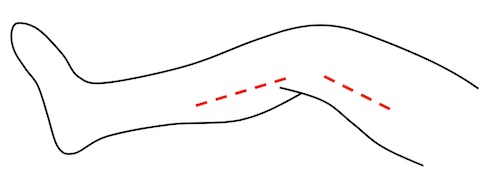
Popliteal Artery Exposure
Abdominal/Retroperitoneal Vascular Exposure
Maneuvers
- Kocher Maneuver
- Right-Sided Medial Visceral Rotation (Cattell-Braasch Maneuver)
- Left-Sided Medial Visceral Rotation (Mattox Maneuver)
- Cephalad Transverse Mesocolon Reflection
- *Understand that There is Significant Overlap with the Maneuvers & They Should be Tailored to the Individual Patient
Exposure/Technique